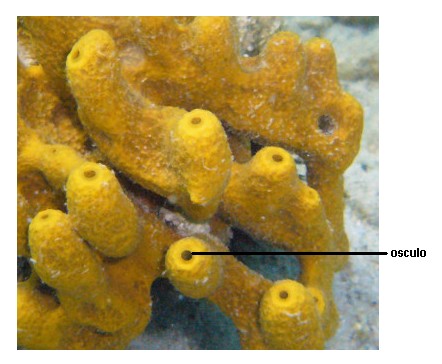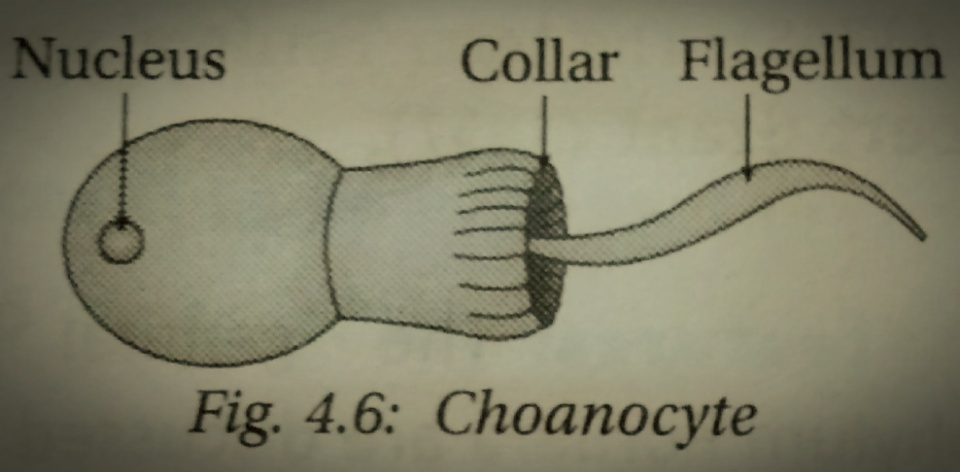|
Spongocoel
A spongocoel (), also called paragaster (or paragastric cavity), is the large, central cavity of sponges. Water enters the spongocoel through hundreds of tiny pores ( ostia) and exits through the larger opening (osculum The osculum (plural "oscula") is an excretory structure in the living sponge, a large opening to the outside through which the current of water exits after passing through the spongocoel. Wastes diffuse into the water and the water is pumped thr ...). Depending on the body plan of the sponge (which can be asconoid, syconoid, or leuconoid), the spongocoel could be a simple interior space of the sponge or a complexly branched inner structure. Regardless of body plan or class, the spongocoel is lined with choanocytes, which have flagellum, flagella that push water through the spongocoel, creating a current. The spongocoel is lined by a variety of cell types, each having a unique function: * porocytes – line the pores of the sponge and are the structure through wh ... [...More Info...] [...Related Items...] OR: [Wikipedia] [Google] [Baidu] |
Sponge
Sponges, the members of the phylum Porifera (; meaning 'pore bearer'), are a basal animal clade as a sister of the diploblasts. They are multicellular organisms that have bodies full of pores and channels allowing water to circulate through them, consisting of jelly-like mesohyl sandwiched between two thin layers of cells. Sponges have unspecialized cells that can transform into other types and that often migrate between the main cell layers and the mesohyl in the process. Sponges do not have nervous, digestive or circulatory systems. Instead, most rely on maintaining a constant water flow through their bodies to obtain food and oxygen and to remove wastes. Sponges were first to branch off the evolutionary tree from the last common ancestor of all animals, making them the sister group of all other animals. Etymology The term ''sponge'' derives from the Ancient Greek word ( 'sponge'). Overview Sponges are similar to other animals in that they are multicellular, he ... [...More Info...] [...Related Items...] OR: [Wikipedia] [Google] [Baidu] |
Ostium (sponges)
Sponges, the members of the phylum Porifera (; meaning 'pore bearer'), are a basal animal clade as a sister of the diploblasts. They are multicellular organisms that have bodies full of pores and channels allowing water to circulate through them, consisting of jelly-like mesohyl sandwiched between two thin layers of cells. Sponges have unspecialized cells that can transform into other types and that often migrate between the main cell layers and the mesohyl in the process. Sponges do not have nervous, digestive or circulatory systems. Instead, most rely on maintaining a constant water flow through their bodies to obtain food and oxygen and to remove wastes. Sponges were first to branch off the evolutionary tree from the last common ancestor of all animals, making them the sister group of all other animals. Etymology The term ''sponge'' derives from the Ancient Greek word ( 'sponge'). Overview Sponges are similar to other animals in that they are multicellular, het ... [...More Info...] [...Related Items...] OR: [Wikipedia] [Google] [Baidu] |
Osculum
The osculum (plural "oscula") is an excretory structure in the living sponge, a large opening to the outside through which the current of water exits after passing through the spongocoel. Wastes diffuse into the water and the water is pumped through the osculum carrying away with it the sponge's wastes. Sponges pump large volumes of water: typically a volume of water equal to the sponge's body size is pumped every five seconds. The size of the osculum is regulated by contractile myocytes. Its size, in turn, is one of the factors which determines the amount of water flowing through the sponge Sponges, the members of the phylum Porifera (; meaning 'pore bearer'), are a basal animal clade as a sister of the diploblasts. They are multicellular organisms that have bodies full of pores and channels allowing water to circulate through t .... It can be closed completely in response to excess silt in the water. References Sponge anatomy {{animal-anatomy-stub ... [...More Info...] [...Related Items...] OR: [Wikipedia] [Google] [Baidu] |
Asconoid
Sponges, the members of the phylum Porifera (; meaning 'pore bearer'), are a basal animal clade as a sister of the diploblasts. They are multicellular organisms that have bodies full of pores and channels allowing water to circulate through them, consisting of jelly-like mesohyl sandwiched between two thin layers of cells. Sponges have unspecialized cells that can transform into other types and that often migrate between the main cell layers and the mesohyl in the process. Sponges do not have nervous, digestive or circulatory systems. Instead, most rely on maintaining a constant water flow through their bodies to obtain food and oxygen and to remove wastes. Sponges were first to branch off the evolutionary tree from the last common ancestor of all animals, making them the sister group of all other animals. Etymology The term ''sponge'' derives from the Ancient Greek word ( 'sponge'). Overview Sponges are similar to other animals in that they are multicellular, he ... [...More Info...] [...Related Items...] OR: [Wikipedia] [Google] [Baidu] |
Choanocyte
Choanocytes (also known as "collar cells") are cells that line the interior of asconoid, syconoid and leuconoid body types of sponges that contain a central flagellum, or ''cilium,'' surrounded by a collar of microvilli which are connected by a thin membrane. They make up the choanoderm, a type of cell layer found in sponges. The cell has the closest resemblance to the choanoflagellates which are the closest related single celled protists to the animal kingdom (metazoans). The flagellae beat regularly, creating a water flow across the microvilli which can then filter nutrients from the water taken from the collar of the sponge. Food particles are then phagocytosed by the cell. Anderson, D. (2001) ''Invertebrate Zoology'' Oxford University Press Location Choanocytes are found dotting the surface of the spongocoel in asconoid sponges and the radial canals in syconoid sponges, but they comprise entirely the chambers in leuconoid sponges. Function By cooperatively moving their ... [...More Info...] [...Related Items...] OR: [Wikipedia] [Google] [Baidu] |
Flagellum
A flagellum (; ) is a hairlike appendage that protrudes from certain plant and animal sperm cells, and from a wide range of microorganisms to provide motility. Many protists with flagella are termed as flagellates. A microorganism may have from one to many flagella. A gram-negative bacterium ''Helicobacter pylori'' for example uses its multiple flagella to propel itself through the mucus lining to reach the stomach epithelium, where it may cause a gastric ulcer to develop. In some bacteria the flagellum can also function as a sensory organelle, being sensitive to wetness outside the cell. Across the three domains of Bacteria, Archaea, and Eukaryota the flagellum has a different structure, protein composition, and mechanism of propulsion but shares the same function of providing motility. The Latin word means " whip" to describe its lash-like swimming motion. The flagellum in archaea is called the archaellum to note its difference from the bacterial flagellum. Eukaryotic ... [...More Info...] [...Related Items...] OR: [Wikipedia] [Google] [Baidu] |
Porocyte
Porocytes are tubular cells which make up the pores of a sponge known as ostia. Description Covering the sponge is a layer of cells known as the pinacoderm, which is composed of pinacocytes. In a sponge, pinacocytes are a thin, elastic layer which keeps water out. Between the pinacocytes, there are the porocytes that allow water into the sponge. Myocytes are small muscular cells that open and close the porocytes. They also form a circular ring around the osculum and help in closing and opening of it. Once through the pores, water travels down canals. The opening to a porocyte is a pore known as an ostium. In sponges, like Scypha, there are some cells that have an intracellular pore. These cells are known as porocytes. They are present in the Leucosolenia (an asconoid sponge) in the body wall through which water enters the body or they are present in Scypha ''Sycon'' is a genus of calcareous sponges belonging to the family Sycettidae Sycettidae is a family of calcareous spong ... [...More Info...] [...Related Items...] OR: [Wikipedia] [Google] [Baidu] |
Amebocyte
An amebocyte or amoebocyte () is a mobile cell (moving like an amoeba) in the body of invertebrates including cnidaria, echinoderms, molluscs, tunicates, sponges and some chelicerates. They move by pseudopodia. Similarly to some of the white blood cells of vertebrates, in many species amebocytes are found in the blood or body fluid and play a role in the defense of the organism against pathogens. Depending on the species, an amebocyte may also digest and distribute food, dispose of wastes, form skeletal fibers, fight infections, and change into other cell types. Limulus amebocyte lysate, an aqueous extract of amebocytes from the Atlantic horseshoe crab (''Limulus polyphemus''), is commonly used in a test to detect bacterial endotoxins. In sponges, amebocytes, also known as archaeocytes, are cells found in the mesohyl that can transform into any of the animal's more specialized cell types. In tunicates they are blood cells and use pseudopodia to attack pathogens that enter the bloo ... [...More Info...] [...Related Items...] OR: [Wikipedia] [Google] [Baidu] |




